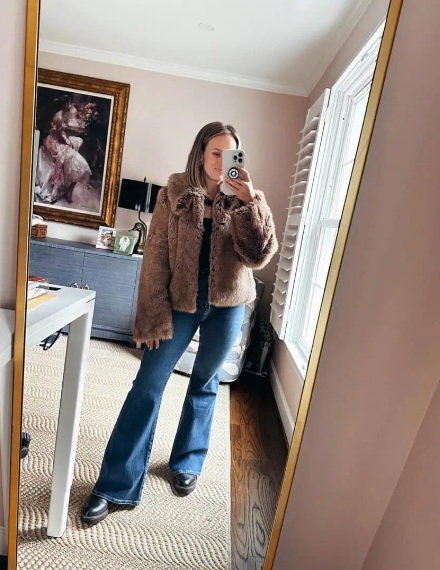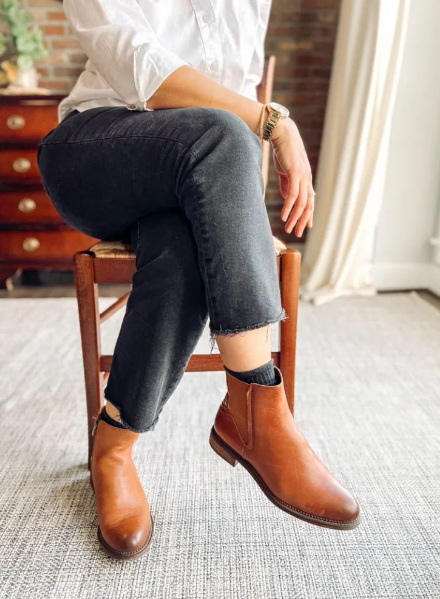Content Menu
● The Importance of Proper Fit
● Key Elements of a Perfect Fit
● Sizing Guidelines
● How to Check the Fit
● What to Do If Your Boots Don't Fit Perfectly
● Materials and Fit
● A Brief History of Chelsea Boots
● Styling Tips
● How to Style Chelsea Boots for Various Occasions
● Taking Care of Your Chelsea Boots
● Common Mistakes to Avoid
● Conclusion
● FAQ
>> 1. How snug should Chelsea boots be around the ankle?
>> 2. Should I size up or down when buying Chelsea boots?
>> 3. What type of socks should I wear with Chelsea boots?
>> 4. How can I stretch Chelsea boots that are too tight?
>> 5. What can I do if my heel slips in my Chelsea boots?
● Citations:
Chelsea boots are a versatile and timeless footwear choice, seamlessly blending style and comfort. Whether you're dressing for a casual day out or a more formal occasion, Chelsea boots can elevate your look[1]. However, achieving the perfect fit is crucial to fully enjoy their benefits[5]. This guide will walk you through the key aspects of how Chelsea boots should fit, ensuring both comfort and style.

The Importance of Proper Fit
A well-fitted Chelsea boot is essential for both comfort and aesthetics[5]. Boots that are too tight can cause discomfort and potential foot problems, while those that are too loose may look sloppy and lead to instability[5]. A proper fit ensures a sleek silhouette, provides adequate support, and allows you to wear your Chelsea boots with confidence.
Key Elements of a Perfect Fit
- Snug Heel Fit: Your heel should fit snugly in the boot, with minimal to no slippage as you walk[5]. Excessive heel movement can cause friction and blisters[5]. The fit should be secure, preventing your heel from lifting out of the boot.
- Comfortable Toe Box: There should be enough room in the toe box for your toes to wiggle comfortably without feeling cramped[5]. A thumb's width of space between your longest toe and the front of the boot is a good guideline[5]. Avoid boots that are too tight, as they can cause discomfort and foot issues. However, ensure your foot doesn't slide too far forward.
- Elastic Side Panels: The elastic side panels are a defining feature of Chelsea boots, and they should fit comfortably against your ankles[5]. They should stretch enough to allow you to easily slip the boots on and off, but not so loosely that they gap or feel constrictive[5].
- Ankle Fit: Chelsea boots should have a snug fit around the ankle, providing a sleek and streamlined appearance[5]. Gaps around the ankle can detract from the boot's aesthetic and make them feel less secure[5]. Using a shoehorn can assist in achieving a snug fit around the ankle[5].
- Width: The width of the Chelsea boots should accommodate your foot comfortably without squeezing it. If your feet feel cramped, consider trying a wider fit. The boots should hug your feet without causing discomfort.
Sizing Guidelines
- True to Size: Chelsea boots generally fit true to size. Start by trying your regular shoe size and adjust as needed based on the fit of different areas of your foot.
- Try On Later in the Day: Feet tend to swell throughout the day, so it's best to try on Chelsea boots in the afternoon or evening to ensure a comfortable fit when your feet are at their largest.
- Wear Appropriate Socks: When trying on Chelsea boots, wear the type of socks you plan to wear with them regularly. Thicker socks may require a half-size up, while thinner socks may work well with a true-to-size fit.
- Consider Different Brands: Sizing can vary between brands and styles, so it's essential to try on different options to find the best fit for your feet. Some brands offer different width fittings to accommodate various foot shapes.
How to Check the Fit
1. Walk Around: Take a walk in the Chelsea boots to assess the overall fit and comfort. Pay attention to any areas of rubbing, pinching, or slippage.
2. Check Heel Movement: Ensure your heel stays securely in place as you walk, with minimal to no lifting.
3. Wiggle Your Toes: Make sure you can comfortably wiggle your toes without feeling restricted.
4. Assess Elastic Panel Fit: The elastic side panels should feel snug but not constrictive. They should allow for easy movement and flexibility[5].
What to Do If Your Boots Don't Fit Perfectly
- Stretching: If your Chelsea boots feel too tight in certain areas, you may be able to stretch them slightly. Leather stretching sprays and shoe stretchers can help to gently expand the boots for a more comfortable fit.
- Insoles: If your boots feel too loose, adding insoles can take up extra space and provide a more secure fit. Tongue pads can also help fill extra space.
- Professional Help: A cobbler can offer expert advice and make adjustments to improve the fit of your Chelsea boots.
Materials and Fit
The material of Chelsea boots can influence how they fit and feel. Leather boots, for example, may stretch and mold to your feet over time, while synthetic materials may retain their shape. Consider the properties of different materials when selecting your Chelsea boots[2].

A Brief History of Chelsea Boots
The Chelsea boot boasts a rich history, dating back to the Victorian era[3][8]. J. Sparkes-Hall, a London-based shoemaker, is credited with designing the first Chelsea boot for Queen Victoria[3][8]. These were initially known as "paddock boots" and were characterized by their elastic side panels, making them easy to slip on and off[3].
The boots gained popularity among equestrians due to their practicality[3][8]. The elastic panels allowed for easy removal after riding[3][8]. Chelsea boots became a symbol of practicality and comfort.
In the 1960s, Chelsea boots experienced a resurgence in popularity, becoming a staple in British mod culture[3]. Icons like The Beatles and The Rolling Stones frequently wore them, boosting their popularity worldwide[3]. They have since transcended social classes, becoming a favorite of designers and even royalty[3].
Styling Tips
- Ankle vs. Mid-Calf: Chelsea boots come in ankle-length and mid-calf options. Ankle-length boots are more versatile, while mid-calf boots make more of a statement.
- Color: Choose colors that complement your wardrobe. Neutral tones like black, brown, and tan are versatile and can be paired with various outfits[1].
- Outfits: Chelsea boots can be worn with jeans, chinos, dresses, and skirts[6]. They can be dressed up or down depending on the occasion[1].
How to Style Chelsea Boots for Various Occasions
Chelsea boots are incredibly versatile and can be styled for a wide range of occasions[1][6]. Here's how to make the most of them:
- Casual Days: Pair your Chelsea boots with jeans and a t-shirt for an effortlessly cool look[1]. Add a sweater or jacket when it gets chilly[1].
- Smart-Casual Vibes: For a polished weekend look, wear your Chelsea boots with chinos, a collared shirt, and maybe a tweed jacket[1].
- Office Ready: Swap out your usual office shoes for a sleek pair of Chelsea boots. Make sure your trousers are hemmed to sit just above the ankle for a clean, streamlined look[1].
- Outdoor Adventures: Opt for rugged Chelsea boots, pairing them with jeans and a sweater[1].
- Formal Events: Choose a polished leather pair and match them with a tailored suit for a modern and timeless look[1].
Taking Care of Your Chelsea Boots
Proper care is essential to prolonging the life and maintaining the appearance of your Chelsea boots[2][7]. Here's a guide to keeping them in top condition:
- Regular Cleaning: Clean your Chelsea boots regularly to prevent dirt and grime from damaging the material[2]. For leather boots, use a soft brush or cloth to remove loose dirt. Use a mild soap solution or leather cleaner for the surface, applying gently in circular motions[2]. For suede boots, use a suede brush to remove dirt and stains[2][7]. Avoid using water directly on suede[2][7].
- Conditioning and Protection: Leather benefits from regular conditioning to keep it soft and supple[2][7]. Apply a leather conditioner after cleaning, working it into the leather with small, circular motions[2]. For suede, use a suede protector spray to repel water and stains[2][7].
- Weatherproofing: Protect your boots from the elements with weatherproofing sprays[7]. This is especially important during wet or snowy conditions.
- Resoling: Many Chelsea boots have Goodyear welted soles, which can be resoled when they wear out[1]. This extends the life of your boots.
- Proper Storage: Store your Chelsea boots in a cool, dry place away from direct sunlight. Use shoe trees to help maintain their shape.
- Putting Them On: Use the pull tabs or a shoehorn to avoid overstretching the elastic sides[1]. This helps them last longer[1].
Common Mistakes to Avoid
- Wearing Pants That Are Too Wide: Avoid wearing Chelsea boots with wide-leg pants, as they can swallow the boots[4]. Opt for straight-tapered or slim-tapered jeans[4].
- Neglecting Maintenance: Failing to clean and condition your boots can lead to premature wear and damage[2][7].
- Choosing the Wrong Size: Wearing boots that are too tight or too loose can cause discomfort and foot problems[5].
- Ignoring Material-Specific Care: Different materials require different care methods[2][7]. Using the wrong products can damage your boots.
The Enduring Appeal of Chelsea Boots
Chelsea boots have maintained their popularity for over a century due to their unique combination of style, comfort, and practicality[3][8]. Their sleek design makes them suitable for various occasions, and their ease of wear adds to their appeal[1][6]. Whether you're dressing for a formal event or a casual outing, Chelsea boots are a reliable and stylish choice[1].
Conclusion
Finding the perfect fit for your Chelsea boots is essential for both comfort and style[5]. By paying attention to the key elements of fit, such as heel stability, toe room, elastic panel comfort, and ankle snugness, you can confidently select a pair that looks and feels great[5]. Remember to try on boots later in the day, wear appropriate socks, and consider different brands to find the ideal match for your feet[5]. With the right fit and proper care, Chelsea boots will become a versatile and beloved addition to your wardrobe[2][7].

FAQ
1. How snug should Chelsea boots be around the ankle?
Chelsea boots should fit snugly around the ankle, providing a sleek and streamlined appearance[5]. Gaps can detract from the boot's aesthetic and make them feel less secure[5].
2. Should I size up or down when buying Chelsea boots?
Generally, Chelsea boots fit true to size. Start with your regular shoe size and adjust based on how the boots feel on your feet, especially considering the toe box and heel fit.
3. What type of socks should I wear with Chelsea boots?
Wear the type of socks you plan to wear regularly with your Chelsea boots when trying them on. Thicker socks may require a half-size up, while thinner socks may work well with a true-to-size fit.
4. How can I stretch Chelsea boots that are too tight?
Leather stretching sprays and shoe stretchers can help gently expand Chelsea boots that are too tight. A cobbler can also provide professional stretching services.
5. What can I do if my heel slips in my Chelsea boots?
Try adding insoles or heel grips to take up extra space and prevent your heel from slipping. If the slippage is significant, consider trying a smaller size or a different brand.
Citations:
[1] https://tribune.com.pk/story/2490376/how-to-style-chelsea-boots-for-every-occasion
[2] https://www.oswinhyde.com/blogs/news/caring-for-your-chelsea-boots-tips-to-maintain-their-elegance
[3] https://www.morjas.com/row/blog/history-chelsea-boots/
[4] https://www.youtube.com/watch?v=iYFhECl-xNM
[5] https://vessi.com/blogs/the-forecast/how-should-chelsea-boots-fit-essential-guidelines-for-the-perfect-look-and-comfort
[6] https://americanwomanblog.com/how-to-style-cheslea-boots/
[7] https://www.aquila.com.au/style-guide/how-to-care-for-leather-boots
[8] https://www.campobelloshoes.com/the-history-behind-chelsea-boots.
[9] https://www.youtube.com/watch?v=7TKOPVmhipE
[10] https://www.ahume.co.uk/blog/chelsea-boots-the-ultimate-buyers-guide/
[11] https://www.vogue.com/article/chelsea-boots
[12] https://www.reddit.com/r/allenedmonds/comments/x2lh1y/proper_care_for_my_first_pair_of_liverpool/
[13] https://en.wikipedia.org/wiki/Chelsea_boot
[14] https://www.youtube.com/watch?v=5g3YebbafM8
[15] https://www.joserealshoes.com/blogs/noticias/the-ultimate-guide-to-chelsea-boots-everything-you-need-to-know
[16] https://www.sumissura.com/en/blog/how-to-style-chelsea-boots
[17] https://www.harpersbazaar.com/fashion/trends/a4413/how-to-take-care-of-leather-and-suede-boots/
[18] https://www.cheaney.co.uk/blog/a-guide-to-chelsea-boots-your-new-favourite-boot-for-every-day/
[19] https://www.gentlemansgazette.com/casual-boots-mistakes/
[20] https://www.pavers.co.uk/blogs/how-should-chelsea-boots-fit

















